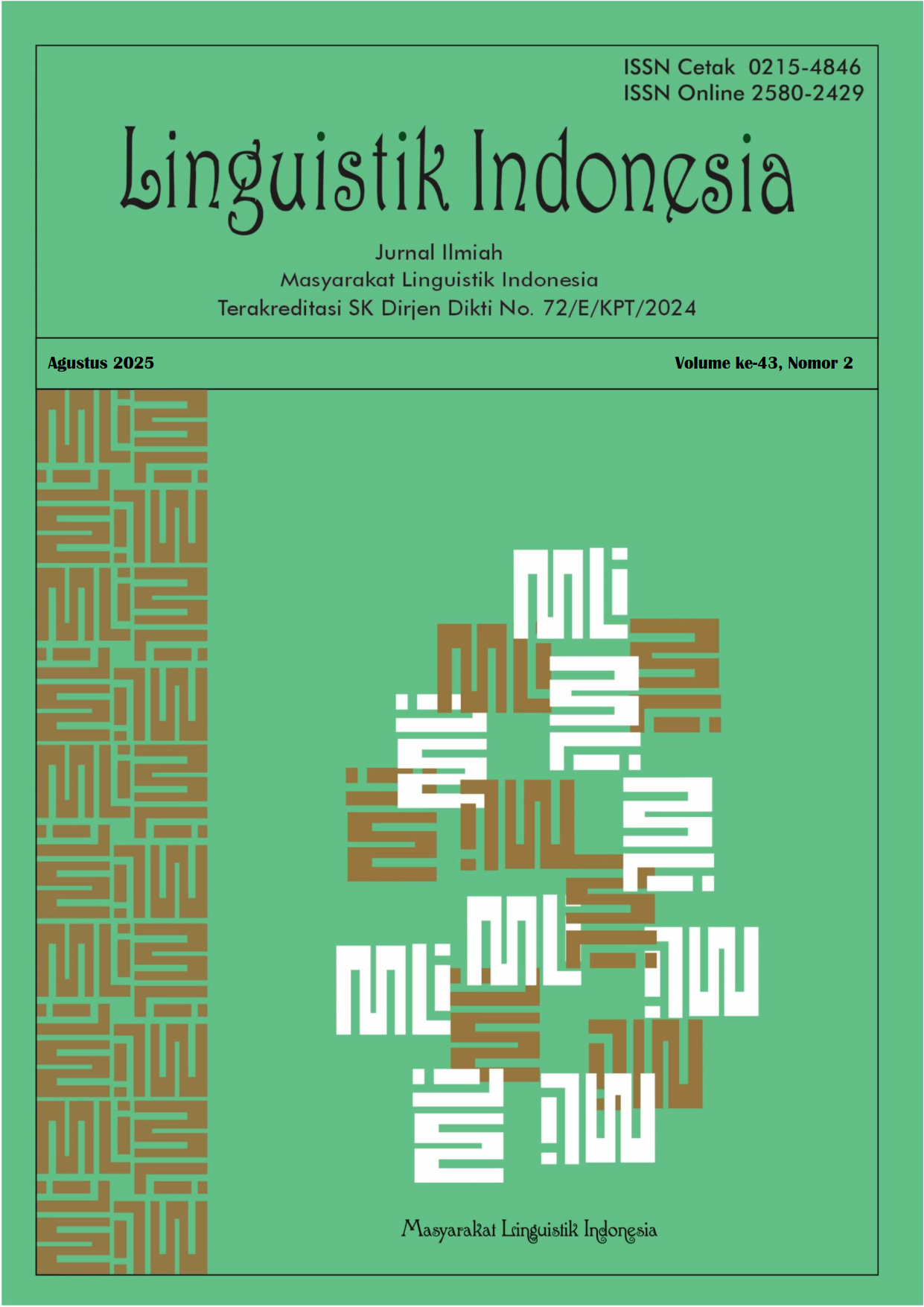Broadening, Narrowing, Bifurcation, and Shift: Semantic Change Mechanisms from Proto-Austronesian to Mandailing
DOI:
https://doi.org/10.26499/li.v43i2.809Keywords:
Semantic change, Proto-Austronesian, MandailingAbstract
This study seeks to identify and analyze semantic shifts in vocabulary from the Proto-Austronesian (PAN) language to the Mandailing language, employing a comparative historical linguistic approach. The principal data sources are a Proto-Austronesian vocabulary list and a collection of basic vocabulary obtained directly from native Mandailing speakers. The selected vocabulary items demonstrate similarities in both form and meaning. Data were collected using in-depth interviews with native Mandailing speakers to gather authentic and contextually relevant vocabulary and semantic data. Additionally, participatory observations were conducted to capture the context of vocabulary usage in everyday life that can affect changes in meaning. Data analysis was conducted through a process of data condensation, followed by the organization and presentation of the findings in descriptive narratives. Subsequently, data interpretation and conclusion drawing were carried out based on patterns and themes that emerged from the presented data. The results of the study revealed four main types of changes in meaning: broadening, narrowing, bifurcation, and shifting. This study contributes to the fields of historical linguistics and semantics, highlighting the importance of understanding meaning changes within the broader context of the linguistic and cultural evolution of the Mandailing people.
References
Blust, R. A. (2013). The Austronesian Languages. Canberra: Pacific Linguistics. https://digitalcollections.anu.edu.au/handle/1885/10191
Crowley, T. (1983). Introduction to Historical Linguistics. Port Moresby: University of Papua New Guinea Press.
Crowley, T., & Bowern, C. (2010). An Introduction to Historical Linguistics. Edisi ke-4. Oxford: Oxford University Press.
Daulay, P., & Mulyadi. (2020). Struktur semantis verba psikologi bahasa Mandailing. Linguistika, 27(2), 174–185.
Effendi, R. (2013). Warisan kosakata bahasa Proto-Austronesia dalam bahasa Banjar. Jurnal Sosial Humaniora Asia (AJSSH), 2(2), 358–379.
Jayana & Dardanila. (2020). Perubahan makna bahasa Proto Austronesia ke bahasa Gayo: Kajian Linguistik historis komparatif (Skripsi Sarjana, Universitas Sumatera Utara). Repositori USU.
Keraf, G. (1991). Tata Bahasa Rujukan Bahasa Indonesia. Jakarta: Grasindo.
Keraf, G. (1984). Diksi dan Gaya Bahasa. Jakarta: Gramedia.
Sibuea, P., Ayumi, F., Az-zahra, S., Nur, S., & Fitria, R. (2024). Analisis relasi makna dalam bahasa Mandailing. Jurnal Nakula: Pusat Ilmu Pendidikan, Bahasa dan Ilmu Sosial, 2(5), 123–132.
Siregar, E. D., Ernanda, & Afria, R. (2022). Perubahan bunyi Bahasa Proto Austronesia (PAN) pada Bahasa Karo, Bahasa Toba, Bahasa Pakpak, Bahasa Simalungun, Bahasa Mandailing dan Bahasa Angkola: Kajian linguistik historis komparatif dan fonologi. Kalistra: Kajian Linguistik dan Sastra, 1(2), 116–130.
Sukma, W., Widayati, D., Dardanila, & Lubis, T. (2024). Perubahan bunyi Bahasa Proto Austronesia ke dalam Bahasa Melayu Riau dialek Pasir Pengaraian. Deskripsi Bahasa, 7(2), 99–121.
Wurm, S. A., & Wilson, B. (1975). Daftar rekonstruksi English Finder dalam Bahasa Austronesia (Pasca Brandstetter). Canberra: Departemen Linguistik, Sekolah Riset Studi Pasifik, Universitas Nasional Australia.
Downloads
Published
How to Cite
Issue
Section
License
Copyright (c) 2025 Linguistik Indonesia

This work is licensed under a Creative Commons Attribution-NonCommercial-ShareAlike 4.0 International License.
The name and email address in this journal will only be used for the benefit of the Indonesian Linguistics journal and will not be used for other purposes.










